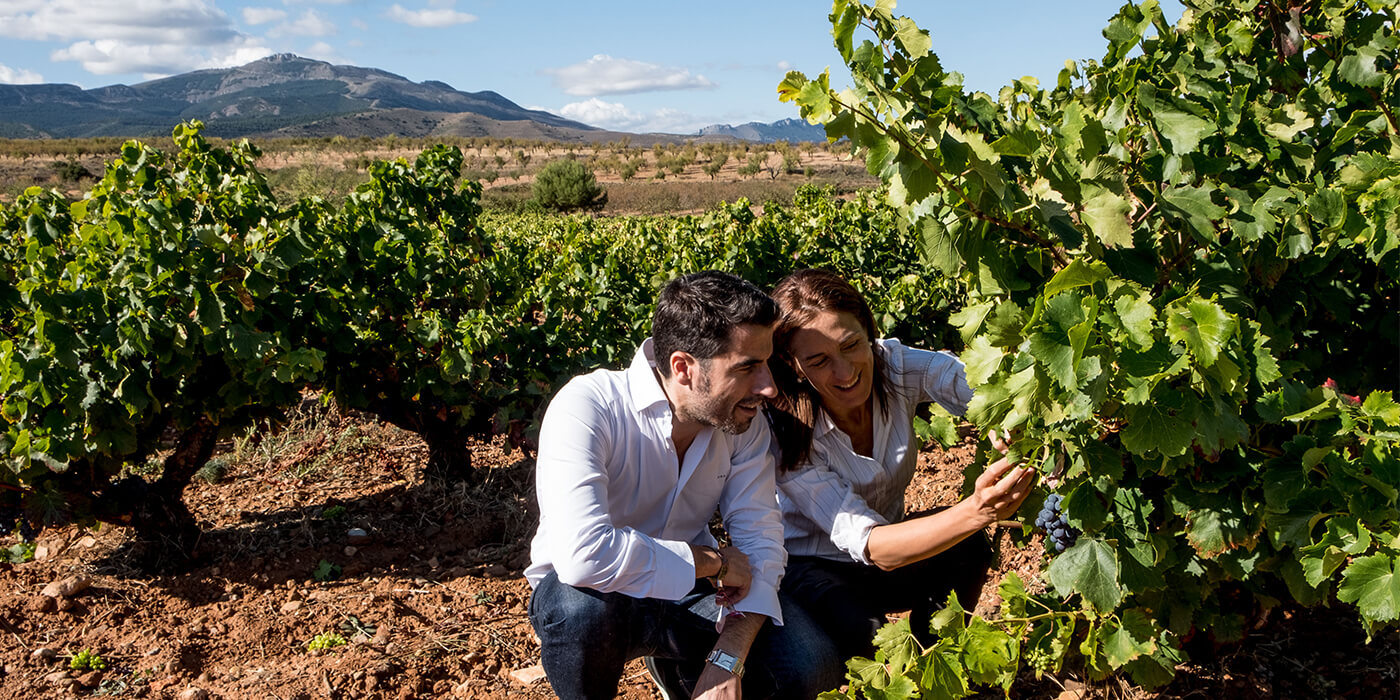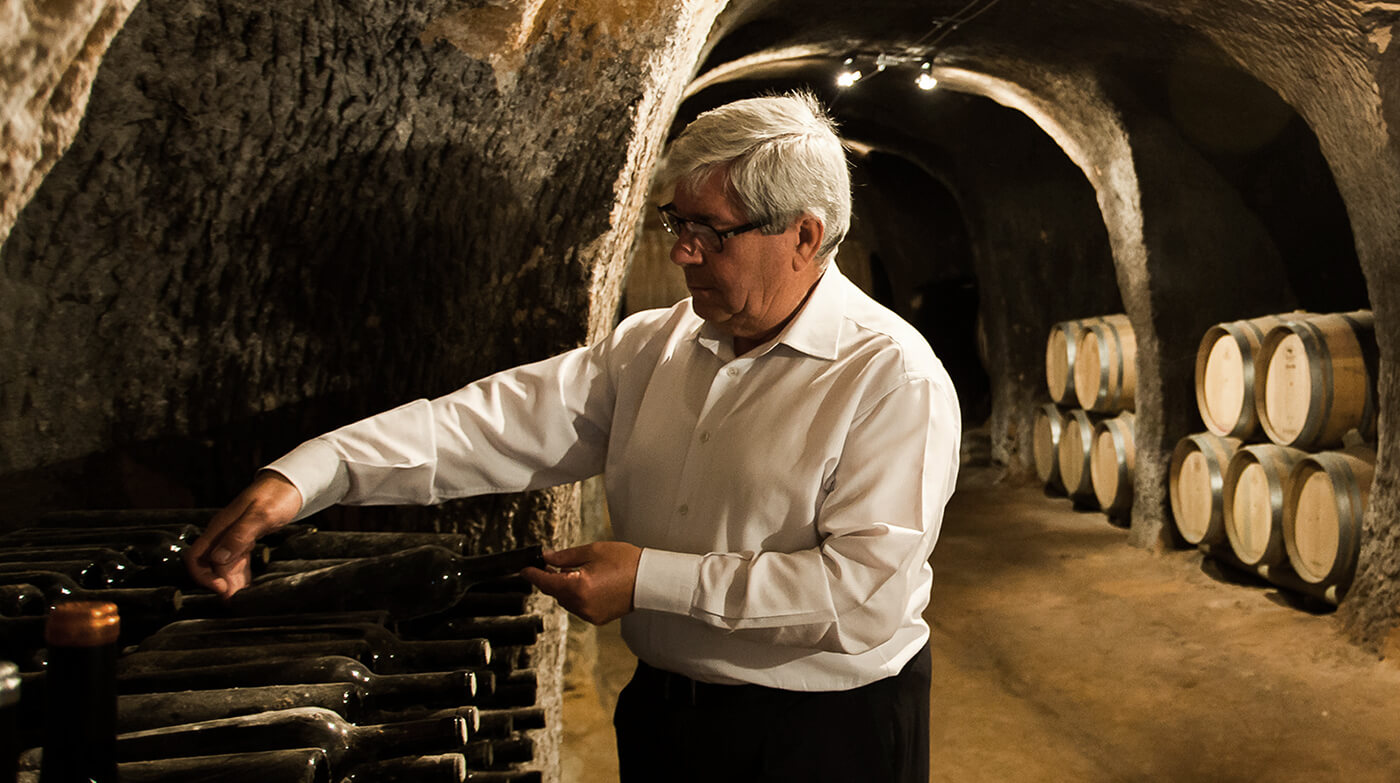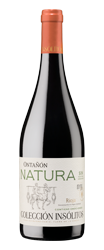Insólitos collection
Adventurers
LaGarnacha
Biodiversity on the edge

Remote vines of
Yerga

Biodiversity is one of the keys to the environment of Ontañón Familia’s vineyards
100% Garnacha * Remote vines of Yerga * 100% Garnacha * Remote vines of Yerga *
Garnachas from the Sierra de Yerga, the aromatic identity.
This rich and complex panorama to a large extent shapes the biodiversity in which our vines are just another element in the living tapestry of an ecosystem which, as François Chartier explains in his manifesto ‘Biodiversity: the missing link in the global concept of terroir’, has an impact on the aromas of the grapes cultivated in such amazing enclaves as those of Quel, and consequently, in the aromatic identity of the resulting wines. Like in this Ontañón La Garnacha, a fine, silky wine with subtle mineral notes, wild red berries and a delicate fluidity.
Ontañón LaGarnacha has been created to delve into the finesse and elegance of the rich tradition of the wines of this variety which is so closely tied to the winemaking heritage of Rioja Oriental, and of Quel in particular.
En esta región, hemos estado llevando a cabo un meticuloso trabajo de recuperación durante la última década, apostando por los clones ancestrales de la zona, la diversidad de suelos y la altitud en viñedos ubicados en límites de cultivo. En la elaboración de Ontañón La Garnacha, combinamos diferentes parcelas de viñedos de la Sierra de Yerga, pequeñas fincas de garnachas con más de treinta años de antigüedad, que se encuentran en una mezcla de suelos en laderas y solanas con una gran cantidad de cantos rodados.
The remarkable history of the Quel Garnachas
The history of garnacha and its arrival in Rioja is not sufficiently documented, although two key historical moments do exist which are connected to vineyard diseases: oidium (powdery mildew), in the year 1854, and in the first third of the 20th century, with the various plans for replanting after the phylloxera disaster. From the first moment, the locality of Quel stood out in its plantations of garnacha and in the panoply of vineyards of this variety we have the gem of El Arca, an estate of less than a hectare from the end of the 19th century, one of the oldest vineyards in the whole of the DOCA Rioja, and which is, without doubt, a remote witness of the arrival of this variety in Rioja.
University of La Rioja teachers Fernando Martínez de Toda and Juan Carlos Sancha published an article in the Zubía magazine in 1995 entitled ‘Variedades de vid cultivadas en Rioja a lo largo de la historia’, (Grape varieties cultivated in Rioja through history) and the first reference to garnacha appeared in an 1846 manuscript annotated in the Casa de las Señoritas de Briñas entitled ‘Prebención para la elaboración de vinos destinados a Ultramar’, in which it speaks of the success obtained by wines made using ‘Tempranillo mixed with Garnacha, Graciana or Mazuela’.
The first written reference in the world referring to the garnacha variety dates back to 1321. In a sentence of the Parliament of Paris a shipment is mentioned consisting of 1,387 barrels of half griece wine (name which possibly refers to muscatel and malvasía wines which came from Greece) and half varnacie (garnacha), the type of wine that the Venetian merchants spread around Europe from 1204.

Quel Garnachas before bud break
Quel
The Agriculture Department of the Diputación de Navarra, set up in 1896, performed an extraordinary task in the foundations of the replanting of the vineyards which had been affected by phylloxera at the end of the 19th century. With Nicolás García de los Salmones, one of the fathers of agricultural engineering in Spain, at its head, this body became a point of reference at both national and international level in the sphere of viticulture.
In this context, García de los Salmones proposed holding a National Viticulture Congress to mark the 7th Centenary of the battle of Las Navas de Tolosa. His idea was accepted and the event took place between the 10th and 22nd July 1912. Over 1,500 attendees took part, from more than twenty European and American countries. On the 17th the King attended and chaired the academic session. The number of talks presented by the best national and international specialists was 46, covering topics related to viticulture and oenology, as is reflected in the Minutes published by the Diputación two years later (1914).
Variedades por pueblos
En una de las ponencias más decisivas del evento, García de los Salmones presentó una lista de 42 variedades cultivadas en la provincia de Logroño y 26 en la de Álava.
Como subrayan Martínez de Toda y Sancha, esta relación “es la más extensa de cuantas aparecen en la bibliografía sobre el inicio de patrimonio varietal vitícola de Rioja”.
Y lo extraordinario es que Nicolás García de los Salmones menciona el cultivo de las variedades por pueblos y destaca a Quel como el principal núcleo de garnacha en Rioja. (También subraya a Quel por la presencia de la mazuela y el anavés y chasela).
Es la primera vez en la historia que se realiza una cuantificación del patrimonio varietal vinculando variedades con localidades y esto aún da más valor al origen histórico de las garnachas de Quel, las pioneras de Rioja.

Cover of the General Report of the 1912 National Congress of Viticulture
The document
Chart from the talk by Nicolás García de los Salmones.
General study of all the Spanish vine plants
Quel appears as the birthplace of Garnacha and other varieties.
After the phylloxera plague, which destroyed a large part of the Rioja vines, there was a second big boost for the planting of garnacha in Rioja and particularly in Rioja Oriental. The Diputación Foral de Navarra directed the work to recover vine plantations and went with this variety. Thus, the close vicinity of the villages of Navarra with those of La Rioja meant that a transfer of grafts was commonplace for the creation of the new rioja vineyards after the disaster of this brutal plague.

General study of all the Spanish vine plants, Quel
“La Garnacha” from Ontañón, exceptional finesse
Quel

Leticia Pérez Cuevas, with one of the old Garnachas from Ontañón Familia
One of the first descriptions of garnacha is the work of José Valier and it sounds beautiful:
“Garnacha is the plant of poor, dry, arid soils, like those with a lot of silica or sand, stony ones and the sulphates and calcareous carbonate on slopes and at altitude. It is beautiful and very robust, with abundant leaves, light-green on both sides, and its clusters are well spread and hang from the node of its third mérithaille, so that very few touch the ground. It stands drought and little or bad tilling, and finally, pets eat its leaves in preference to any of the other species. It is, in a word, the poor man’s vine. Its wine, always sweet or semi-sweet, ferments if the temperature of the space it is in rises to 34 degrees centigrade”.
Juan Marcilla, a pioneer in the microbiology of winemaking in Spain, described garnacha thus:
“Upright carriage, very hairless adult leaves, medium or small in size, and light green in colour. Very abundant flowering, but fruit setting is never complete, especially on Ruprestis de Lot. The grapes ripen late and achieve a lower alcoholic strength and greater acidity than tinto de Madrid. The colour of the wines is not intense and they have a marked tendency to turn ‘onion skin colour’, of oxidised wine, with ageing”.
The vineyard
One of the Ontañón Family’s great passions is the vineyard and that is why we are recovering old bush vines and planting new garnachas with genetic material from the Quel district. We use vertical training to achieve the best ventilation and insolation of the clusters. The soils in which these vines stand are poor and we fertilize them with the organic matter left by the flocks of sheep which eat their leaves at the end of each harvest.

The beautiful landscape of our Garnachas. In the background, the Sierra de Yerga.
Garnacha from Quel * Pioneers of Rioja * Garnacha from Quel * Pioneers of Rioja *
Winemaking process of LaGarnacha, passion for luscious tannin

Old bocay from the Bodegas neighborhood of Quel.
The temperatures
8 degrees in the pre-fermentative maceration.
The must has not fermented yet and does not contain alcohols and an exchange of compounds takes place between solid and liquid parts. We look for nuances of colour and aroma which will contribute to the singular nature of the wine. The skins provide a good quantity of colour, thanks to the extraction of anthocyanins in the aqueous phase, which will help us to polymerise with the tannins and stabilise the colour of the wine; primary aromas which are the ones which come from the field and the ones we will fix in a first stage as a reminder of the variety and the zone.
28 degrees at the start of fermentation.
for the multiplication of the yeasts and to ensure the right fermentation of the must till the end, the time when we increase the extraction of colour. The yeasts come from our vineyards and are native to the Quel district.
23 degrees for fixing the fruit aromas.
We must guarantee the end of the fermentation phase and control the temperatures perfectly, so as to be able to combine the primary and secondary aromas and to make the variety, zone and fruit dominate in the whole of the wine’s life
Mixed barrels
We are looking for a sweet tannin that fills the mouth, the sensation of silkiness on the palate. The ripe, sweet tannins of these garnachas are blended with the tannin from the French and American-oak barrels over the five months it spends ageing. The staves of the barrels are made of American oak and the lids from French oak. The percentage of contact of the wine with the oak is as follows:
70 % AMERICAN OAK
30 % FRENCH OAK
The result
The result is a sensation of length and roundness in the mouth. The finesse we are seeking in a wine which expresses the personality of Quel garnacha to perfection.

Selection in the vineyard is key to achieving the desired finesse.
Tasting
A bright, cherry-red wine, very lively and with darker shades at the rim.
Nariz muy varietal, frutal y mineral, dotado de enorme complejidad y mucha elegancia. Notas florales que van hacia la fruta roja como la cereza, ciruela y las fresas con una sensación mineral y fresca.
Acidez vibrante, persistente en boca y muy envolvente. Elegancia que se sostiene en un paso sedoso y delicado. Aportando un post-gusto aterciopelado y largo que nos invita a seguir degustándolo y disfrutarlo con la delicadeza y sutileza que nos embriaga en cada sorbo.
14,5%

Gabriel Pérez, in one of the traditional wineries from Quel, where the first Rioja Garnachas were made.
Download
Tasting Notes 2020
· PDF ·
Image Bottle
· JPG ·
Label
· PDF ·
Ontañón LaGarnacha catalogue
· PDF ·



